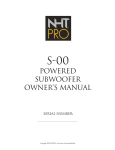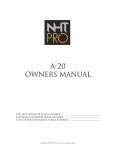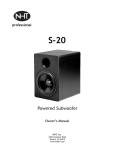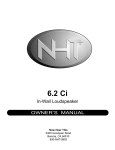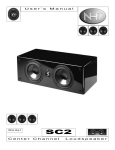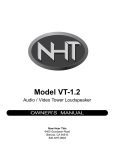Download NHT M-20 Speaker User Manual
Transcript
® Pro Audio M-20 Powered Monitor Owner’s Manual M-20 Control Amplifier Serial Number: M-20 Monitor Serial Number: Rev. 6.06 Safety Instructions -- Please Read First CAUTION: To reduce the risk of electric shock, do not remove the cover (or back). No user serviceable parts are inside; refer servicing to qualified personnel. WARNING: To reduce the risk of fire or electric shock, do not expose this appliance to rain or moisture. This symbol wherever it appears, alerts you to the presence of uninsulated dangerous voltage inside the enclosure that may be sufficient to constitute a risk of electric shock. CAUTION RISK OF ELECTRIC SHOCK DO NOT OPEN WARNING: SHOCK HAZARD-DO NOT OPEN. AVIS: RISQUE DU CHOC ELECTRONIQUENE PAS OUVRIR. This symbol, wherever it appears alerts you to important operating and maintenance instructions in the accompanying literature. Read the manual. DETAILED SAFETY INSTRUCTIONS: All the safety and operation instructions should be read before the appliance is operated. Retain Instructions: The safety and operating instructions should be retained for future reference. Heed Warnings: All warnings on the appliance and in the operating instructions should be adhered to. Follow Instructions: All operation and user instructions should be followed. Water and Moisture: The appliance should not be used near water (e.g. near a bathtub, washbowl, kitchen sink. laundry tub, in a wet basement, or near a swimming pool etc.). Ventilation: The appliance should be situated so that its location or position does not interfere with its proper ventilation. For example, the appliance should not be situated on a bed, sofa, rug, or similar surface that may block the ventilation openings, or placed in a built-in installation, such as a bookcase or cabinet that may impede the flow of air through the ventilation openings. Heat: The appliance should be situated away from heat sources such as radiators, heat registers, stoves, or other appliances (including other amplifiers) that produce heat. Power Source: The appliance should only be connected to a power supply of the type described in the operating instructions or as marked on the appliance. Grounding and Polarization: Precautions should be taken so that the grounding or the polarization means of the appliance is not defeated. Power Cord Protection: Power supply cords should be routed so that they are not likely to be walked on or pinched by items placed upon or against them, paying particular attention to cords and plugs, convenience receptacles and the point where they exit from the appliance. Cleaning: The appliance should only be cleaned as recommended by the manufacturer. Non-use Periods: The power cord of the appliance should be unplugged from the outlet when left unused for a long period of time. Object and Liquid Entry: Care should be taken so that objects do not fall and liquids are not spilled into the enclosure through openings. Damage Requiring Service: The appliance should be serviced by qualified service personnel when; The power supply cord or the plug has been damaged; or Objects have fallen, or liquid has been spilled into the appliance; or The appliance has been exposed to rain; or The appliance does not appear to operate normally or exhibits a marked change in performance; or The appliance has been dropped, or the enclosure damaged. Servicing: The user should not attempt to service the appliance beyond what is described in the Operating Instructions. All other servicing should be referred to qualified service personnel. INTRODUCTION: Thank you for selecting and purchasing the M-20. Your studio monitors are a critical element in the countless decisions made during recording, mixing, and mastering and must deliver a transparent, neutral sound so you have the information you need to choose and place microphones, set eq’s, balance mixes; ie, to deliver exceptional product. Multiple M-20’s deliver state-of-the-art multi channel monitoring capability. If you require assistance at any time during or after the setup process, call our Customer Service Hot Line at 1-800-NHT-9993 (648-9993). You can also visit our web site at www.nhtpro.com for more in-depth technical information. GETTING STARTED: The M-20 is unique in that it combines a dedicated control amplifier with a separate loudspeaker cabinet, using controlled impedance cables that actually form part of the crossover network. By designing the system as an integral package of control amp, cables, and monitor, many of the advantages of selfpowered speakers can be realized without the possible attendant performance compromises of fully integrated designs. WARNING: The M-20 monitor speaker must only be used with the M-20 Control Amp, cables, and vice versa. The following are included in the Control Amplifier carton: 1 - Control Amplifier 1 - 6' IEC Power Cord 1 - Warranty Registration Card 1 - 20' Monitor Output Cable 4 - 10-32 Rack Mounting Screws 8 - Plastic Insulating Washers Screws M-20 Amplifier Front Panel Insulating Washers Rack Rail Fig. 1: Rack Mounting Detail INITIAL INSTALLATION: The M-20 Control Amplifier may be used on a shelf, or mounted in a standard 19” equipment rack using the screws and washers supplied. One vertical rack space is required, but we recommend you leave at least one additional open space above and below the M-20 Control Amplifier for improved cooling, as you would with any high power amplifier. For table or shelf use, the four feet MUST remain attached to allow for air circulation. As a starting point for speaker placement, position all M-20 monitors equidistant from the listening position. For more detailed speaker placement information see page 7. SYSTEM CONNECTIONS: CAUTION: MAKE ALL CONNECTIONS WITH THE AC POWER TURNED OFF! POWER CONNECTIONS/FUSE: The power cord receptacle contains a spare fuse located within the power connector. To get at the fuse, remove the power cord and use a small flat head screwdriver to access the fuse compartment. When replacing the fuse with a spare, use only a fuse of the same current rating. Located next to the power cord receptacle is a voltage selector, preset at the factory for the destination country; the power cord supplied is appropriate for that voltage. Confirm the voltage selector setting before powering up the system. CONTROL AMPLIFIER INPUT SECTION: The M-20 Control Amplifier accepts both balanced and unbalanced inputs on either XLR or 1/4” TRS connectors. These connectors are connected in parallel within the M-20 to allow for convenient equipment chaining, but only one input should be physically connected to the unit at any time. Figure 3a shows the proper wiring schematic for each type of connector. Since there are so many different connector types and signal levels employed by source equipment, some experimentation may be necessary. Keep in mind that the M-20 can accept a wide range of signals and has an input sensitivity control on the front panel. 2 PIN SIGNAL 2 1 3 XLR 1 GND 2 + 3 _ A-20 INPUT SOURCE 3 1 + (SIGNAL) 2 3 - (GND) 1 Shield TRS Fig. 3b Unbalanced Wiring Diagram Fig. 3a Balanced Wiring Diagram SPEAKER CONNECTIONS: The M-20 includes a 20’ special purpose cable to connect the Control Amplifier to the Monitor. While this cable looks similar to a standard microphone cable, it is constructed with lower and more consistent conductor impedance. Portions of the M-20’s crossover circuitry are located in both the amplifier and speaker enclosures, and the cable supplied is an important part of this electrical network. This allows the speaker cable to function as a neutral and transparent component in the system. Replacing or extending the supplied cable with any other type will have a varying and unpredictable impact on the sound. If your installation requires the use of alternative cables, you may consult the Cable Measurement Data Chart on our website. Be sure they are wired as shown in Fig. 3a. Using the included cable to connect the M-20 Monitor to the Control Amplifier is quite simple and straightforward: fit the XLR connectors into the corresponding connectors on the Control Amplifier and Monitor until the connector locks. WARNING: IF USING CABLES OTHER THAN THOSE SUPPLIED WITH THIS SYSTEM, BE SURE THAT NO CONDUCTOR IS WIRED TO THE XLR CASING. FAILURE TO DO SO MAY CONSTITUTE A RISK OF ELECTRIC SHOCK. Fig. 4 Typical installation FUSE TYPE: T9A 250V FOR 110/120V. T5A 250V FOR 220/240V. 50/60Hz - 950W 115 INPUT VOLTAGE To AC outlet CAUTION RISK OF ELECTRIC SHOCK DO NOT OPEN M-20 MONITOR CONTROL AMPLIFIER. M-20 MONITOR INPUT SERIAL NO: WARNING: SHOCK HAZARD - DO NOT OPEN. AVIS: RISQUE DU CHOC ELECTRONIQUE NE PAS OUVRIR. NHTPro BENICIA, CALIFORNIA, U.S.A. MADE IN CHINA G1 CAUTION: FOR CONTINUED PROTECTION AGAINST FIRE REPLACE ONLY WITH SAME TYPE 250V FUSE. Source CAUTION: CONNECTING OUTPUT TO ANY PRODUCT OTHER THAN THE M-20 MONITOR MAY RESULT IN SEVERE EQUIPMENT DAMAGE. To monitor via supplied red cable USING THE M-20 CONTROL FUNCTIONS: The M-20 controls are designed for utility and repeatability under varying conditions and make only subtle impact on the basic character and accuracy of the speaker. We encourage you to experiment with fine tuning the system to your particular requirements. CONTROL M-20 AMPLIFIER Fig. 5 M-20 Control Amplifier Front Panel POWER INDICATORS: Two LED’s are located to the immediate left of the power switch on the M-20 Control Amplifier:. The top (green) LED lights up indicating there is AC power to the amplifier and the POWER SWITCH is turned “On”. The lower (red) LED indicates a clipping or overload condition. Occasional flashing of this indicator is a gentle warning you are reaching the system’s limits. If the red LED glows continually, severe clipping is occurring and the input signal or system gain should be reduced to avoid the risk of possible system damage. SYSTEM STATUS DISPLAY: Located in the center of the front panel, a unique system status display informs you of the operating state of your system. Three small LED’s(green for average SPL, yellow for AC line voltage, and blue for heat sink temperature)respond to your setting the square MODE switch to the right of the System Status Display to the desired mode. SPL: This is a reading of the long term average sound pressure level calibrated at 2 meters from the M-20 monitor, and derived from the amplifier output voltage. Peak sound levels are ignored. The readout is designed to report overall listening levels and to help realize consistent monitoring from hour to hour, session to session and room to room. Levels under 68 dB are shown as “00”; levels over 120 dB are shown as “HI”. Since monitoring level has a profound influence on the perception of sonics, periodically checking SPL helps to assure consistent results. VAC: This is a reading of the AC power line voltage being supplied to the M-20. It is useful for assuring that power conditions are correct and sufficient for all the equipment on the circuit. Sustained readings below 110 V may limit your maximum output levels, and could indicate that the AC circuit is overloaded. Continuous readings above 125 V indicate an AC circuit problem, which could lead to amplifier failure. TMP: This is a reading of the output heat sink temperature in Centigrade. Typically, you should expect this to run between 40°C and 60°C, depending on listening and ambient conditions. If you find that your Control Amplifier unit tends to run hotter than 60°C, it is recommended that you improve the ventilation around it. The M-20 Control Amplifier contains a protection circuit that automatically shuts the amplifier down if the heat sink temperature reaches 100°C. SENSITIVITY: This function controls input sensitivity with settings at -10dB, -3dB, +4dB, +11dB and (M)ute to provide noise-free, consistent gain matching with a wide variety of equipment. The proper setting is the lowest sensitivity possible (highest dB number) which allows the speaker to reach the maximum desired output without source clipping. Professional devices typically specify full output at +4dB, most consumer audio products reach full output at -3dB; most computer sound cards at -10dB. Consult the owner’s manual of the source device driving to the M-20 Control Amplifier for its output level specifications and set the SENSITIVITY control accordingly. BOUNDARY CONTROL: Reflective boundaries, such as floors, walls, even table tops, reinforce a speaker’s low frequency output. Conversely, placing speakers out into a room decreases bass response. The greatest low frequency output is with the BOUNDARY control in the “0” position, which assumes no significant boundary reinforcement is present. Each control step attenuates low frequencies by 1.5 dB (at 50 Hz), with rapidly decreasing effect above 300 Hz. Refer to the diagram in Fig. 6 for information on setting the control appropriately. Quarter/Half Space Quarter Space 2 0 2 0 BOUNDARY BOUNDARY Half/Whole Space 1 1 1 2 Half Space Whole Space 1 1 0 2 BOUNDARY 2 0 0 BOUNDARY BOUNDARY Fig. 6. Boundary Control Settings Diagram POSITION CONTROL: Near field monitoring reduces the effect of room acoustics on the signal, and provides greater sonic detail. Mid and far field monitoring conversely reveal aspects of room ambience and are more representative of end use. With increased listening distance, a speaker’s upper frequency power response attenuates due to room influences and air absorption. The M-20 may be adjusted to compensate for this change, and provide flat response at various listening distances. Setting the control in the “FF” (far-field) position gives the maximum high frequency output. Each step counter clockwise (moving toward the near-field position) attenuates the 20 kHz by an additional .75 dB with the effect rolling off at 3 kHz. See Fig. 7 for appropriate POSITION control settings for various listening distances. Listener Distance 0’ 1.5m 1m 3m 2.5m 2m Far-Field M-20 Monitor Mid-field Near field MF MF FF NF POSITION POSITION MF MF FF NF FF NF POSITION MF FF NF POSITION Fig. 7. Position Control Settings Diagram FF NF POSITION SPEAKER PLACEMENT: The M-20 Monitor System is intended to provide consistent performance over a wide range of placement situations. This is accomplished through the use of electrical controls, wide dispersion drivers, advanced enclosure design and carefully chosen crossover characteristics. Nevertheless, it is always worth investing time and effort experimenting with optimum loudspeaker placement. In all cases, the M-20 Monitors should be set up the same distance from the listening position. (see fig. 8 below) This is important in order to insure equal arrival time of all channels to the listening position. Ideally, the tweeter height on the M-20 monitor, as with all channels, should be on axis with your ears, or slightly above. Also, remember that nearby reflective surfaces (including video monitors) can alter impulse response, blur imaging and change tonality; giving the M-20 as much room as possible assures the highest-quality reproduction. M-20 2 M- M2 0 0 B The Distance of A=B=C=D=E E 0 D C 2 M- A M2 0 Fig. 8 Ideal 5.1 Surround Monitor Placement SYSTEM OPERATION: The M-20 is capable of very high output levels, especially when listening in the near-field. Still, every speaker system has its limits. Harsh breakup at extremely high volume, or heat emanating from the drivers is an indication that the system has exceeded its output limits and that you should lower the playback level. Watch for excessive lighting of the front-panel overload indicator on the Control Amplifier. Speaker damage most often occurs from sustained high volume levels, not from transient sounds or brief musical peaks. Protect your ears and use common sense. M-20 MONITOR SYSTEM CARE: Except for the occasional flattering comment, your M-20 System needs no regular maintenance. Never attempt to clean the M-20 Monitor driver units except for very light feather dusting. The M-20 Monitor cabinets and the M-20 Control Amplifier front panel can be cleaned using a damp, soft cotton cloth first sprayed with a mild, non-abrasive glass cleaner and with the unit unplugged and AC power off. Never spray the speaker or amplifier directly! Avoid silicone and oil based cleaners or treatments. NEED SOME HELP? Technical Support can be reached several ways: Telephone us 800-NHT-9993 (648-9993, E-mail us at: [email protected], Fax us at: (707) 747-1252 or write us at: NHT, 6400 Goodyear Rd. Benicia, CA 94510. Or visit our web site at www.nhtpro.com. SYSTEM SPECIFICATIONS: SYSTEM/MONITOR: Type: Modular, two piece powered near/mid/far field monitor. Configuration: 2-way acoustic suspension. Woofer: 6.5" curvilinear treated paper. Butyl surround. Tweeter: 1" metal dome, textile surround, ferro-fluid cooled and damped. Magnetic Shielding: Full Loudspeaker Dimensions/Wgt.: 14" h x 8" w x 9.375” d, 19 lbs. Shipping weight: 22lbs./10 kg. Loudspeaker Materials: 0.75" MDF. CONTROL AMPLIFIER: Amplifier Power: 250W (continuous rms), 400W (100ms peak). Peak Acoustic Output: 111 dB SPL (100ms pink noise @ 1M). Residual hum/noise: <10 dB SPL @ 1M. System THD @ 90 dB SPL: <0.4% (100Hz ~ 10kHz @ 1M). Response: +/- 2 dB (1/3 oct. swept noise): 48Hz ~ 20kHz@ 1M, 45Hz ~ 20kHz @ 2M. -6dB LF cutoff: 40Hz (in-room response). Control Amplifier Dimensions/Wgt.: 1.75" h x 19" w x 13.375" d/19 lbs. Shipping weight 25.7lbs./11.7 kg. FEATURES/CONTROLS: Connectors: Input: XLR, TRS. Output to monitor: XLR. Controls: Sensitivity: 5 position (-10dB,- 3dB, +4dB, +11dB, Mute). Boundary: 5 position (0.0, 0.5, 1.0, 1.5, 2.0 representing walls). Position: 5 position, near(1m), near-mid(1.5m), mid(2m), mid-far(2.5m), far (3m~). Power: On, off. Display Mode Display: Switchable: SPL Output (68dB ~ 120dB), Line Voltage(90 ~ 135V), Heat Sink o Temp.(20 - 99 C). LED’s: Power, Overload. NHT 6400 Goodyear Rd. Benicia, CA 94510 ph: (707)747-0122 fx: (707)747-1252 www.nhtpro.com








